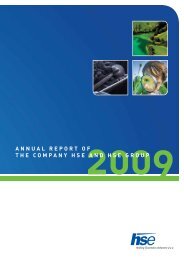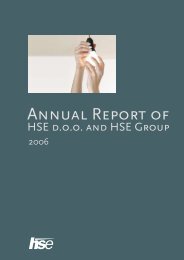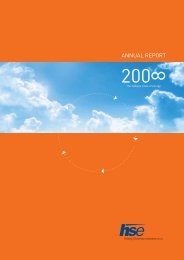Annual report - HSE
Annual report - HSE
Annual report - HSE
You also want an ePaper? Increase the reach of your titles
YUMPU automatically turns print PDFs into web optimized ePapers that Google loves.
It has been estimated that market risks were managed adequately, considering the given<br />
limitations.<br />
Quantity risks<br />
Quantity risk comprises risks arising from production uncertainty, consumption uncertainty<br />
and energy supply uncertainty.<br />
• Production uncertainty is mainly associated with the question whether electricity will<br />
be available in the market. It is also linked to operational risk, which aims to assess<br />
the probability and effect of a turbine or any other production unit failing. Particularly<br />
important is the impact of uncertain hydrology because a large share of electricity is<br />
supplied by hydropower plants.<br />
• Consumption uncertainty arises from the impact of weather and temperature, load<br />
flexibility and seasonal cycles.<br />
• Energy supply uncertainty arises from random failures of power lines and other<br />
equipment, or from interventions by the power transmission network operator due to<br />
transmission line overload.<br />
Risk associated with electricity supply from <strong>HSE</strong> Group<br />
Electricity production is exposed to the following risks of deviation from the planned<br />
supply:<br />
• risk of (absence of) supply of electricity from hydropower plants due to hydrological and<br />
meteorological conditions, and failures and technological limitations to production;<br />
• risk of (absence of) supply of electricity from thermal power plants due to outages or<br />
technological and ecological limitations of production;<br />
• risk of (absence of) supply of coal from the Velenje coal mine due to production hold-ups<br />
caused by outages, failures of technological systems, accidents or other disturbances;<br />
• in periods of increased TPP production, economic limitations or any changes in the<br />
overall method of CO 2<br />
duty payments and in trading in CO 2<br />
emission coupons should<br />
also be considered.<br />
Departure from plans<br />
In 2012, the <strong>HSE</strong> Group HPPs produced 85.5 GWh more than planned, with TEŠ and TET<br />
respectively producing 96.7 GWh 31.5 GWh less than planned, which resulted in the <strong>HSE</strong><br />
production deficit of 43.7 GWh in terms of quantity planned.<br />
The deviations of actual daily flows of water from daily forecasts are also reflected in<br />
deviations of hydropower production from the forecast schedules. To the extent possible,<br />
the deviations were balanced out by adjusting production at TPPs and increasing sales and<br />
purchases.<br />
At the thermal power plants, a 2 to 4% unexpected production shortfall has to be considered<br />
in addition to the planned shutdowns due to overhauls. This percentage corresponds to<br />
ten to twenty daily production shortfalls, which can be offset by starting up gas-fired<br />
power plants, but only for shorter periods. Alternatively, to the extent possible, shortfalls<br />
can be offset by reallocating the use of HPP accumulation and purchasing electricity on<br />
the market. In 2012, TEŠ’s and TET’s unexpected production shortfall amounted to 2.6%,<br />
and 2.9%, respectively.<br />
Risk of interrupted coal supply from PV<br />
Coal supply may be interrupted due to breakdowns of technological systems and accidents<br />
or other disturbances affecting the extraction of coal. According to an assessment of the<br />
coalmine’s technical management, the majority of potential shortfalls could be addressed<br />
without significant interruptions to production, and rarely would such breakdowns result<br />
in 14-20 days of supply interruptions. There is a relatively low probability of a major<br />
breakdown that would require a six-month shutdown. Based on the above assessment,<br />
minimum joint coal stocks of the <strong>HSE</strong> Group have been determined. They amount to 3,000<br />
TJ (February–October) and 4,000 TJ (November–January).<br />
<strong>Annual</strong> Report <strong>HSE</strong> 2012<br />
2 Business Report<br />
87
















